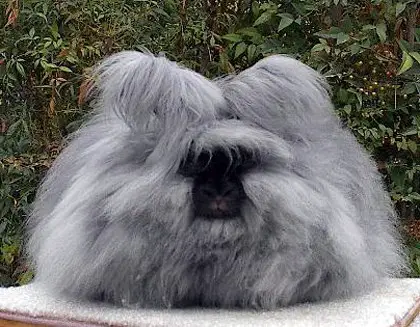Basic Appearance:
The English angora looks like a ball of fluff, to quote the breed standard. They come in many colors, and have long, dense wool over their entire body. English angoras even have wool on their head, ears, feet, and tail.
History, Temperament, and Common Uses:
The exact history of angora rabbits is unknown, but there are Roman records of wooled rabbits as early as 100 BC. The Romans possibly brought their angora rabbits into eastern Europe, as by 500-600 AD angoras were firmly established. The first mention of angoras in England was in the 1500’s. Records from France state that the first angoras appeared in their country in 1723. Angoras were brought to the United States around 1900, and they were primarily show rabbits. In the United States, the French and English angoras were lumped together as one breed until 1944, when the ARBA recognized the English angora as its own breed.
Most English angoras have very nice temperaments, and will calmly let you groom them. They even lie quite still while you groom their bellies.
English angoras are primarily show rabbits in the United States, and they are often Best In Show winners. English angoras are also kept for their wool, which can be spun into yarn.
English angoras have very laid back temperaments, so if you don’t mind grooming all that wool they can make wonderful pets.
Grooming, Care, and Additional Notes:
English angoras have the softest wool of the four angora breeds. They also require the most grooming. Starting at eight weeks of age, your angora will need to be groomed at least once a week. When the rabbit is young, use a wide-toothed comb for grooming. When English angoras reach four or five months old you should start using a slicker brush and grooming twice a week. If grooming is done on a once or twice a week basis, it should take about fifteen minutes to groom your angora. A great source of English angora information, including details on grooming, can be found here: www.bettychuenglishangora.com. When grooming you rabbit, don’t forget to turn it over and check its belly and bottom for mats and debris that may have been caught in the wool.
Because of the danger of the rabbits getting wool block, English angoras should be fed an enzyme supplement to help break down the wool they consume while grooming.
English Angora At A Glance:
Recognized Varieties:
English angoras are shown in two color classification: white and colored.
The white classification includes pointed whites (Himalayan marked), red eyed white (REW), and blue eyed white (BEW).
The varieties in the colored class are chinchilla, chocolate chinchilla, lilac chinchilla, squirrel, chestnut, chocolate agouti, copper, lynx, opal, broken, black, blue, chocolate, lilac, pearl, sable, seal, smoke pearl, blue tortoiseshell, chocolate tortoiseshell, lilac tortoiseshell, tortoiseshell, blue steel, chocolate steel, lilac steel, steel, cream, fawn, and red.
ARBA Body Type:
Compact
Approximate Size:
5 to 7 1/2 pounds
Important Things to Look for When Buying Show Stock:
Wool carries the most points in the English angora standard. The wool should be very dense, with a silky texture. It should be free from mats. It should look healthy, and not part over the back. The underwool should be crimped, with guard hairs present. The wool should be an even length over the rabbit’s entire body, gradually blending to the shorter wool on the belly. The ideal length for the wool is 3 1/2 to 5 inches. Longer wool is not given any advantage. Wool should not be so long that is spoils the “ball of fluff” look of English angoras.
English angoras should be close-coupled and compact. Look for a well-rounded, deep rabbit. The topline should rise from right behind the ears, reach a high point above the hips, than round down smoothly to the base of the tail. The head should be broad with bangs and side trimmings. The ears should be short, carried in a small “V”, and fringed and tasseled. Feet and tail are to have wool.
Things to Avoid:
Wool lacking density, too soft, or cotton-like. Wool that resembles hair or parts over the back. Wool that is coarse is a disqualification. Wool less than 2 inches is a disqualification. Wool that is webbed, matted, felted, lifeless, soft, or packed will be faulted.
Long, narrow body or head. Thin trimmings on head. Lack of trimmings or ear tassels is a disqualification. Normal fur on the feet is a disqualification.

